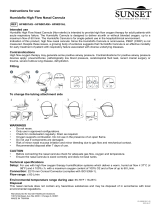
EN - 11
SPECIFICATIONS
DEVILBISS 5-LITER SERIES
Catalog Number 525DS, 525DS-Q 525KS, 525KS-LT 525PS
Delivery Rate (Lower delivery rates available
for low ow applications)
0.5 to 5 LPM 0.5 to 5 LPM 0.5 to 5 LPM
Maximum Recommended Flow (@ nominal
outlet pressures of zero & 7 kPa)**
5 LPM 5 LPM 5 LPM
Outlet Pressure 8.5 ± 0.5 psig (58.6 ± 3.5 kPa) 8.5 ± 0.5 psig (58.6 ± 3.5 kPa) 8.5 ± 0.5 psig (58.6 ± 3.5 kPa)
Auxiliary Oxygen Port **
Outlet Pressure: <15 psi
Outlet Flow: 2 LPM
Outlet Pressure: <15 psi
Outlet Flow: 2 LPM
Outlet Pressure: <15 psi
Outlet Flow: 2 LPM
Electrical Rating 115 V, 60 Hz, 3.3 Amp
220-230 V~, 50 Hz, 1.55 Amp
230 V~, 60 Hz, 1.9 Amp
220-230 V~, 60 Hz, 1.68 Amp
Operating Voltage Range 97-127 V~, 60 Hz
187-253 V~, 50 Hz
195-253 V~, 60 Hz
187-253 V~, 60 Hz
Oxygen Percentage 1-5 LPM=87%-96% 1-5 LPM=93%±3% 1-5 LPM=93%±3%
Operating Altitude
(tested at 70˚F {21˚C} only)
0-1500 M (0-4921 ft)
Across the voltage range:
No degradation of performance
Across the voltage range:
No degradation of performance
Across the voltage range:
No degradation of performance
1500-4000 M (4921-13123 ft)
Tested at nominal voltage only:
No degradation of performance
Tested at 230V/50Hz only:
No degradation of performance
Tested at 230V/60Hz only:
No degradation of performance
Operating Environment Range*
41˚F (5˚C) to 95˚F (35˚C), humidity range
of 10% to 95%
No degradation in performance across the
operating voltage range.
No degradation in performance across the
operating voltage range.
No degradation in performance across the
operating voltage range.
Power Consumption
310 Watts Average
275 Watts @ 1.2 LPM & below
230V / 50 Hz - 312 Watts Average
230V / 50 Hz - 296 Watts Average @
1.2 LPM & below
230V / 60 Hz - 387 Watts Average
230V / 60 Hz - 369 Watts Average @
1.2 LPM & below
230V / 60 Hz - 334 Watts Average
230V / 60 Hz - 297 Watts Average @
1.2 LPM & below
Weight 36 lbs. (16.3 Kilograms) 36 lbs. (16.3 Kilograms) 36 lbs. (16.3 Kilograms)
Safe Working Load 53 lbs. (24 Kilograms) 53 lbs. (24 Kilograms) 53 lbs. (24 Kilograms)
Sound Pressure Level at 3 and 5 LPM
(ISO 80601-2-69)
525DS
50.9 dBA @ 3 LPM
50.7 dBA @ 5 LPM
525DS-Q
46.7 dBA @ 3 LPM
46.7 dBA @ 5 LPM
525KS
47.9 dBA @ 3 LPM
47.9 dBA @ 5 LPM
525KS-LT
49.6 dBA @ 3 LPM
49.4 dBA @ 5 LPM
45.4 dBA @ 3 LPM
45.3 dBA @ 5 LPM
Sound Power Level at 3 and 5 LPM
(ISO 80601-2-69)
525DS
54.7 dBA @ 3 LPM
54.5 dBA @ 5 LPM
525DS-Q
50.4 dBA @ 3 LPM
50.4 dBA @ 5 LPM
525KS
51.6 dBA @ 3 LPM
51.7 dBA @ 5 LPM
525KS-LT
53.4 dBA @ 3 LPM
53.2 dBA @ 5 LPM
49.2 dBA @ 3 LPM
49.1 dBA @ 5 LPM
Sound Level (ISO 8359:1996)
48 dBA (525DS)
46 dBA (525DS-Q)
40 dBA (50 Hz (525KS)
48 dBA (50 Hz (525KS-LT)
—
Alarm Sound Level > = 62 dBA > = 62 dBA > = 62 dBA
Dimensions
24.5”H x 13.5”W x 12”D
(62.2 x 34.2 x 30.4 cm)
24.5”H x 13.5”W x 12”D
(62.2 x 34.2 x 30.4 cm)
24.5”H x 13.5”W x 12”D
(62.2 x 34.2 x 30.4 cm)
Maximum Limited Pressure
Normal Condition: 9 PSIG (62.0 kPa),
Single Fault Condition: 27.6 PSIG (190.3 kPa)
Normal Condition: 9 PSIG (62.0 kPa),
Single Fault Condition: 27.6 PSIG (190.3 kPa)
Normal Condition: 9 PSIG (62.0 kPa),
Single Fault Condition: 27.6 PSIG (190.3 kPa)
Operating System Time Cycle / Pressure Swing Time Cycle / Pressure Swing Time Cycle / Pressure Swing
The visible “low oxygen” indicator will
activate at the following level
86% ± 3%
(The audible alarm will alert before O
2
drops
below 82%. At less than 60%, the red “service
required” light will activate.)
86% ± 3%
(The audible alarm will alert before O
2
drops
below 82%. At less than 60%, the red “service
required” light will activate.)
86% ± 3%
(The audible alarm will alert before O
2
drops
below 82%. At less than 60%, the red “service
required” light will activate.)
Storage Conditions -13˚F (-25˚C) to 158˚F (70˚C), humidity range
of 15% to 93% non-condensing, including
condensation
-13˚F (-25˚C) to 158˚F (70˚C), humidity range
of 15% to 93% non-condensing, including
condensation
-13˚F (-25˚C) to 158˚F (70˚C), humidity range
of 15% to 93% non-condensing, including
condensation
Equipment Class and Type
Class II Equipment Double Insulated;
Type B Applied Part, IP21
Class II Equipment Double Insulated;
Type B Applied Part, IP21
Class II Equipment Double Insulated;
Type B Applied Part, IP21
Approval Body and Safety Standard
TUV
ANSI/AAMI ES60601-1:2005+A2 (R2012) +A1
IEC 60601-1-6:2010
IEC 60601-1-11:2015
ISO 80601-2-69:2014 ***
CAN/CSA-C22.2 No. 60601-1:14
CAN/CSA-C22.2 No. 60601-1-6:11
CAN/CSA-C22.2 No. 60601-1-11:15
CAN/CSA-C22.2 No. 80601-2-69:16
TUV approved for 50 Hz only to
IEC 60601-1:2012
IEC 60601-1-6:2010+A1
IEC 60601-1-11:2015
EN ISO 80601-2-69:2014
TUV
IEC 60601-1:2012
IEC 60601-1-6:2010+A1
IEC 60601-1-11:2015
EN ISO 80601-2-69:2014
CE mark No Yes Yes
EMC Compliance To EN60601-1-2 EN60601-1-2 EN60601-1-2
*
NOTE – The OSD performance at 41˚F (5˚C) to 95˚F (35˚C), 93% R.H. through voltage range on the 525DS veried at 670m.
**The maximum recommended ow is 3 LPM when an oxygen bottle is being lled with oxygen from the auxiliary oxygen port.
*** Use of the 515LF-607 low output ow meter package or other low output ow meter accessory will prevent the device from meeting the requirements of ISO-80601-2-69:2014 Section
201.13.2.101.
Specications subject to change without notice.
A-525D4
















